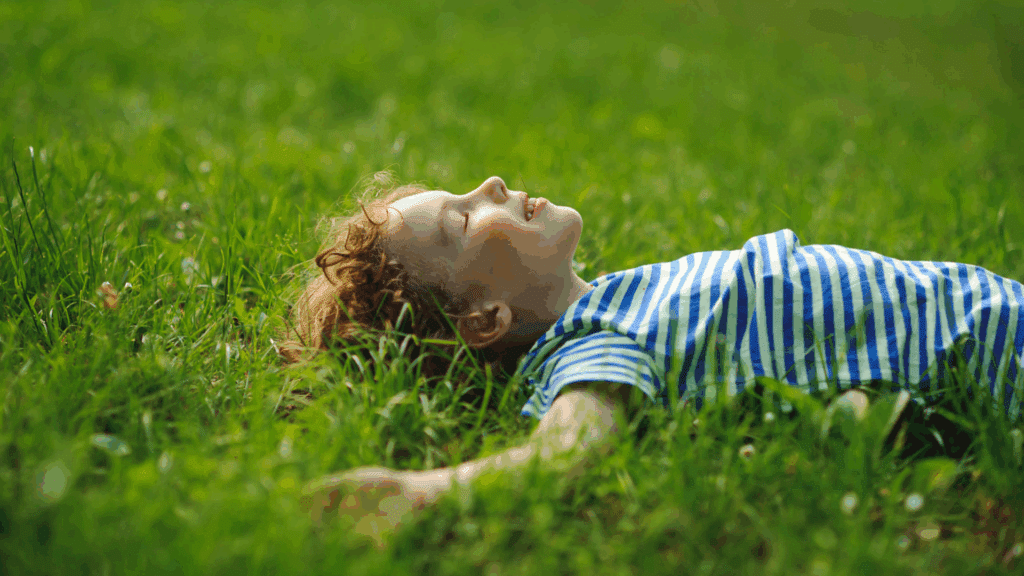Parents often notice their children feeling tense, anxious, or having trouble falling asleep. Many kids don’t know how to manage these feelings on their own.
This blog offers a progressive muscle relaxation script for kids that makes the process fun and easy to follow.
Parents and teachers will find step-by-step instructions they can read aloud to help children practice this beneficial relaxation method.
Benefits of Progressive Muscle Relaxation Script for Kids

Helping children manage stress early in life provides them with valuable skills they’ll use forever. When kids feel overwhelmed, their bodies often respond with physical tension that they may not even notice.
- Better sleep quality: Helps kids calm their bodies and minds before bedtime, making it easier to fall asleep and stay asleep.
- Reduced anxiety: Teaches children how to physically relax, which can lower anxiety levels during stressful situations.
- Improved focus: When kids learn to release physical tension, they can concentrate better on schoolwork and other tasks.
- Body awareness: Helps children recognize when they’re holding tension in their bodies so they can address it early.
- Stress management skills: Gives kids a practical tool they can use throughout life to handle stress.
- Physical health: Reducing muscle tension can help with headaches, stomach aches, and other physical symptoms of stress.
- Self-regulation: Empowers children to take control of their emotional states without depending on others
Progressive Muscle Relaxation Script for Kids

Progressive Muscle Relaxation (PMR) is a simple, fun way for kids to relax their bodies and minds. By tensing and relaxing different muscle groups, children can learn to manage stress and feel calm.
Here are 7 easy progressive muscle relaxation scripts for kids.
1. Squeeze the Lemon
This script helps kids relax by pretending to squeeze a lemon in each hand, tensing and then relaxing their muscles. It’s a playful way to release tension and encourage mindfulness through imaginative play.
Steps to Follow:
- Sit comfortably and close your eyes.
- Pretend you have a lemon in each hand.
- Squeeze the lemons as hard as you can, feeling your hands and arms tighten.
- Hold the squeeze for five seconds.
- Drop the lemons and let your hands relax completely.
- Notice how your hands feel loose and calm.
- Repeat two more times, focusing on the feeling of relaxation.
2. Turtle in a Shell
Kids imagine they are turtles pulling their heads and shoulders into their shells. This script helps them focus on tensing and relaxing their neck and shoulder muscles, promoting a sense of safety and calm.
Steps to Follow:
- Sit or lie down comfortably.
- Pretend you are a turtle.
- Pull your shoulders up to your ears and tuck your chin in, like hiding in your shell.
- Squeeze tightly for five seconds.
- Slowly release and let your shoulders drop.
- Feel the difference between tight and relaxed muscles.
- Repeat the turtle move two more times.
3. Stretchy Cat
Children imagine they are cats stretching after a nap. This script encourages them to tense and relax their arms and back, helping to relieve tension and improve body awareness.
Steps to Follow:
- Sit or lie down and close your eyes.
- Pretend you are a cat stretching after a nap.
- Reach your arms above your head and stretch as far as you can.
- Hold the stretch for five seconds, feeling your muscles tighten.
- Let your arms fall gently to your sides and relax.
- Notice how your body feels softer and looser.
- Repeat the stretch two more times.
4. Elephant Stomp
This playful script uses the imagery of an elephant stomping to help kids tense and relax their leg muscles, grounding them and releasing built-up energy.
Steps to Follow:
- Stand up straight and pretend you are a big elephant.
- Lift one foot and stomp it down, tightening your leg muscles.
- Hold the tension for five seconds.
- Gently relax your leg and feel the difference.
- Repeat with the other leg, stomping and relaxing.
- Notice how your legs feel heavy and calm.
- The elephant stomped two more times on each leg.
5. Robot and Rag Doll
Kids alternate between being a stiff robot and a floppy rag doll, tensing and relaxing their whole bodies. This script is great for teaching the contrast between tension and relaxation.
Steps to Follow:
- Stand or sit and pretend to be a robot.
- Make your whole body stiff and tight, like a robot.
- Hold the tension for five seconds.
- Suddenly turn into a rag doll, letting your body go limp and loose.
- Notice how relaxed you feel compared to before.
- Repeat the robot and rag doll switch two more times.
- Focus on the calmness in your body.
6. Bunny Nose Wiggle
This script uses a bunny’s nose wiggle to help kids focus on relaxing their facial muscles, especially around the nose and cheeks, promoting a gentle and fun relaxation experience.
Steps to Follow:
- Sit comfortably and close your eyes.
- Pretend you are a bunny wiggling your nose.
- Scrunch up your nose and cheeks as tight as you can.
- Hold the scrunch for five seconds.
- Relax your face and let your nose and cheeks go soft.
- Notice how your face feels lighter and calmer.
- Repeat the bunny nose wiggle two more times.
7. Starfish Fingers
Children pretend their hands are starfish, spreading and squeezing their fingers. This script helps them relax their hands and fingers, which can be especially helpful after writing or using devices.
Steps to Follow:
- Sit with your hands resting on your lap.
- Pretend your hands are starfish on the sand.
- Spread your fingers wide, stretching them out as far as you can.
- Hold the stretch for five seconds, feeling the tension.
- Relax your fingers and let them curl gently.
- Notice the difference between tight and relaxed hands.
- Repeat the starfish stretch two more times
When to Use a Progressive Muscle Relaxation Script for Kids
Children face many challenges that can create stress in their young lives. From school pressures to conflicts with friends, kids experience worry and tension just like adults do.
However, they often lack the tools to handle these feelings. Teaching children progressive muscle relaxation gives them a powerful way to take control of their physical responses to stress.
- Bedtime routine: Add it to the nightly ritual to help kids wind down and prepare their bodies for sleep.
- Before tests or performances: Practice the technique before school exams, recitals, or sports games to reduce performance anxiety.
- During emotional outbursts: Use as a calming strategy when a child is upset, angry, or experiencing big emotions.
- Quiet classroom moments: Teachers can lead brief sessions during transition times or after recess to help students refocus.
- Doctor or dentist visits: Practice before appointments that might cause nervousness or fear.
- Travel situations: Use during long car rides, flights, or when visiting new places that might feel overwhelming.
- Daily stress prevention: Incorporate into daily routines as a preventative measure, not just when stress is already high.
The Bottom Line
Giving your child the gift of relaxation skills is one of the most helpful tools for their emotional growth.
Progressive muscle relaxation offers a simple yet powerful way for kids to take charge of their comfort and calm.
Start small, be patient, and make it fun. Children learn best through play and positive experiences. The more you practice together, the more natural this skill will become for them.
Try this script tonight and watch how your child responds. Small steps today lead to big results tomorrow in your child’s improvement toward emotional well-being.




